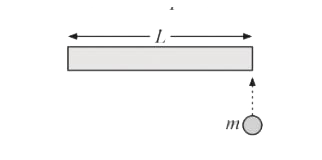A meter stick of length l and mass M lies on a frictionlesss table. The stick is free to move in any way on the table. A hockey ball of mass m moving perpendicuarly to the mass of the ball so that it remains at rest immediately after the collision?
[Hint: Elastic collision means that kinetic energy is conserved in the process. Consider conservation of kinetic energy, conservation of angualr momentum and linear momentum, i.e., 12mv2 = (12Mv2'+12Iε2, mv12=Iε, mv=Mv′.
Eliminate v2' and w2 from the first with the help of the other two. Use the expression I=112MI2]
The correct Answer is:M/4
Step by step video, text & image solution for A meter stick of length l and mass M lies on a frictionlesss table. The stick is free to move in any way on the table. A hockey ball of mass m moving perpendicuarly to the mass of the ball so that it remains at rest immediately after the collision? [Hint: Elastic collision means that kinetic energy is conserved in the process. Consider conservation of kinetic energy, conservation of angualr momentum and linear momentum, i.e., 1/2mv^(2) = (1/2Mv^(2') + 1/2Iepsilon^(2), mv1/2 = Iepsilon, mv = Mv^('). Eliminate v^(2') and w^(2) from the first with the help of the other two. Use the expression I = 1/12 MI^(2)] by Physics experts to help you in doubts & scoring excellent marks in Class 11 exams.
Updated on:21/07/2023Topper's Solved these Questions
- ROTATIONAL DYNAMICS, MOMENT OF INERTIABook:NN GHOSHChapter:ROTATIONAL DYNAMICS, MOMENT OF INERTIAExercise:Exercises
Explore 42 Videos
- MOMENT, TORQUE, EQUILIBRIUM OF BODIESBook:NN GHOSHChapter:MOMENT, TORQUE, EQUILIBRIUM OF BODIESExercise:Exercises
Explore 33 Videos
- SATURATED AND UNSATURATED VAPOURBook:NN GHOSHChapter:SATURATED AND UNSATURATED VAPOURExercise:All Questions
Explore 1 Video
Similar Questions
Assertion : In elastic collision, kinetic energy is conserved.
Reason : Energy is always conserved.
View SolutionA stick of length L and mass M lies on a frictionless horizontal surface on which it is free to move in any way. A ball of mass m moving with speed v collides elastically with the stick as shown in the figure. If after the collision the ball comes to rest, then what would be the mass of the ball?

View Solution
Knowledge Check
A stick of length L and mass M lies on a frictionless horizontal surface on which it is free to move in any way. A ball of mass m moving with speed v collides elastically with the stick as shown in the figure. If after the collision the ball comes to rest, then what would be the mass of the ball?
 Am=2MBm=MCm=M/2Dm=M/4
Am=2MBm=MCm=M/2Dm=M/4During collision kinetic energy is conserved at each instant
AOf inelastic collisionBOf elastic colllisionCBoth (1) and (2)DNone of theseA Stick of length L and mass M lies on a fnctionless horizontal surface on which it is free to move in any way. A ball of mass m moving with speed v collides elastically with the stick as shownin figure-5.115. If after the collision ball comes to rest, then what should be the mass of the ball ?
 Am=2MBm=MCm=M/2Dm=M/4
Am=2MBm=MCm=M/2Dm=M/4
During elastic collision of two balls, is kinetic energy conserved during the short interval of contact of balls ?
View Solution
A stick of length l lies on horizontal table. It has a mass M and is free to move in any way on the table. A bal of mass m moving perpendicularly to the stick at a distance d from its centre with speed v collides elastically with it as shown in figure. what quantities are conserved in the collision ? what must be the mass of the ball, so that it remains at rest immediately after collision?
View SolutionAssertion: Linear momentum is conserved in both elastic and inelastic collisions.
Reason: Total energy is conserved in all collisions.
View SolutionA ball of mass m moving with a speed v makes a head on collision with an identical ball at rest. The kinetic energy after collision of the balls is three fourth of the original kinetic energy. The coefficient of restitution is
View SolutionStatement-1 : Kinetic energy is conserved in both, perfectly elastic and perfectly inelastic collisions.
Statement-2 : Because linear momentum is conserved in both.
View Solution

